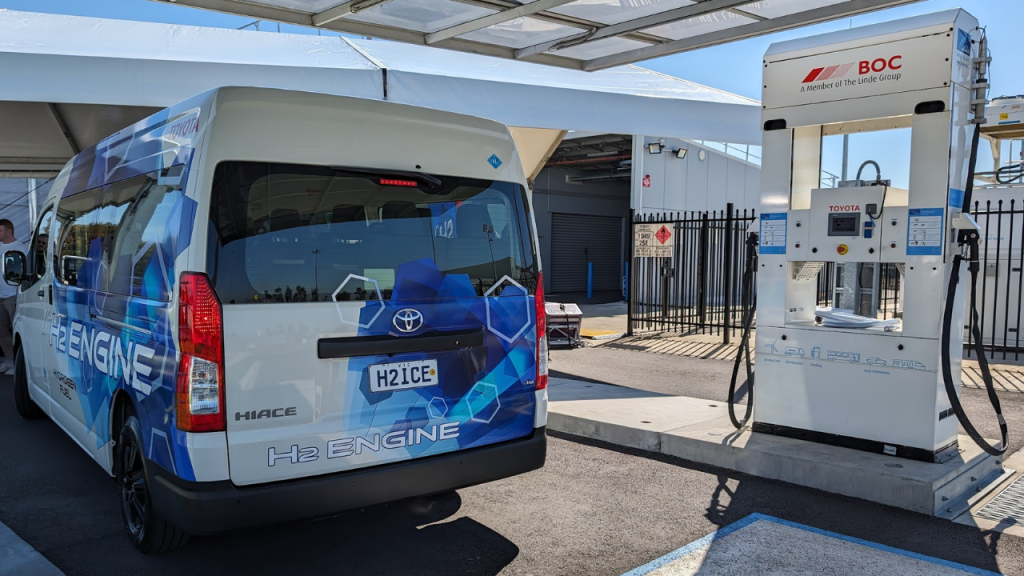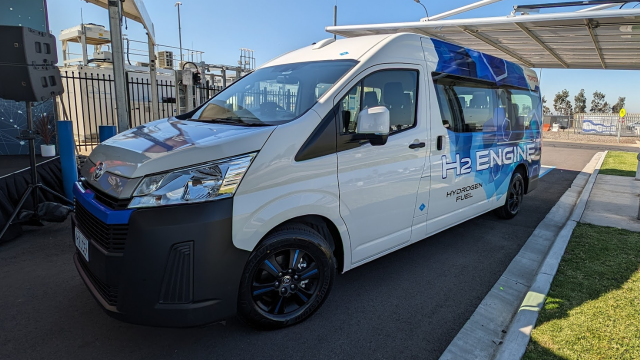Toyota has just revealed its new hydrogen vehicle concept: A hydrogen-powered Hiace van, that uses a different (and in many ways, more interesting) powertrain to the Toyota Mirai hydrogen sedan we drove earlier this year.
Both hydrogen vehicles produce water as a byproduct, but in operation, their function is not the same. The Toyota Mirai is a ‘Fuel-Cell Electric Vehicle’, or FCEV, relying on a motor that converts hydrogen into electricity, feeding through to the car’s battery. That car is not available in Australia unless you’re a business or fleet customer, however, it has been in the market in Japan and parts of the U.S. for some time now.
The Hydrogen Hiace, however, uses a modified V6 turbo petrol engine, an engine seen in LandCruiser 300 Series vehicles overseas, but converted to operate on hydrogen.
The difference in operation here is interesting – it’s a return to internal combustion engine designs, without needing to convert the hydrogen to electricity and lose energy during the conversion process. Because of this, the van makes a familiar petrol-engine vehicle noise, unlike the silence of an EV, although I didn’t catch a whiff of petrol smell.

Testing hydrogen down under
What’s particularly interesting about the Hiace is that it’s being tested in Australia. A customer pilot program is being run between Toyota and other businesses, starting with construction company CPB Contractors, which will use the van to transport workers between sites in Melbourne. Toyota says it is currently speaking to a number of other interested businesses.
“Australia is the perfect place to run such a program with our federal and state governments having already committed $6.3 billion in funding for hydrogen projects under the National Hydrogen Strategy,” Toyota Australia president and CEO Matthew Callachor said.
“We also have an extensive variety of environments and climatic conditions that will enable us to evaluate the hydrogen powertrain technology to its fullest and ensure it delivers on Toyota’s high standards.”
In late October, Toyota, Hyundai, and Ampol announced that they would be working together on planning hydrogen refuelling stations in Canberra, which is particularly essential, considering that there just aren’t many across the entire country.
The hydrogen technology in the Toyota Hiace has been in development since 2017, and in 2021 it was showcased in a Corolla Sport racing car during the Super Taikyu series in Japan – but as far as the Hiace goes, it is still very much a prototype.
The van that I saw at an event hosted by Toyota at its Centre of Excellence in Altona, Victoria, had blue bits added to its external trim, and a wrap had been applied to gloat about its hydrogen powertrain. On the inside, there were bits taped to the dashboard, including monitoring systems and a button for logging events. It’s a very early prototype.
Additionally, Toyota said that this prototype is only capable of a maximum of 200km range – a bit short of the 800km the diesel-powered Hiace can travel up to, though it can refuel entirely within five minutes (much faster than a rivalling electric vehicle can recharge). It’s bound to improve over time, and the company is considering fitting other vehicles with the technology.
It’s also not a zero-emissions vehicle – but the emissions are considerably low. As noted by Which Car, oil is needed to lubricate engine components and nitrogen oxides are still created in burning the oil to ignite the fuel. These are lower emissions than a standard Hiace, of course, but still more than any EV.

How the Hiace factors into Toyota’s decarbonisation efforts
Toyota stressed at the event that this was just going to be a part of its ‘multi-pathway approach’ to decarbonisation. Calling this technology ‘H2-ICE’ (as in, Hydrogen-to-Internal Combustion Engine), it’s being designed to exist in tandem with hybrids (HEVs), plug-in hybrid electric vehicles (PHEVs), battery-electric vehicles (EVs or BEVs), FCEVs, and ‘carbon neutral fuel’ (CN fuel).
While most other automakers are more interested in electric vehicles than any of these other technology types, Toyota’s argument is that other fuel types will be necessary for some purposes – think offroading, or long distances, or when quick refuels are necessary. Toyota Australia vice president of sales, marketing, and franchise operations Sean Hanley claimed that assertions that it was against electrification were “misinformation”, but instead that, at least for right now, switching to EVs won’t work for everyone – not when charging speeds are long, range isn’t massive (though it is improving quickly), and when costs are high (though prices did come down considerably for low-end EVs in 2023).
“In this particular market, Australians need choice. Toyota is offering choice, and today you’re seeing a prototype that showcases just what this company really stands for – choice. and that’s important going forward to decarbonisation,” Hanley said at the reveal event.
It’s worth noting that, despite Toyota leading the charge on hybrids during the 2000s, pioneering the technology and rolling it out to many of its vehicles, the company has been criticised by Greenpeace and InfluenceMap for its electrification efforts, and is considered to be behind on releasing electric models.
Toyota’s first electric vehicle for the Australian market, the BZ4X, is still to be released, after it was initially expected in 2022, delayed through 2023, and now marked for a February 2024 release date. The company has also been teasing other electric vehicles, including an Electric HiLux concept.
I’m really excited to see Toyota develop this technology, but whether or not it ends up being an adequate alternative to current or other developing options, we’ll have to wait and see. The company did not share a date for commercial availability of vehicles with the technology.
Zachariah Kelly travelled to Victoria as a guest of Toyota.
Image: Zachariah Kelly/Gizmodo Australia
Want more Aussie car news? Here’s every EV we’ve reviewed in the last two years, all the EVs we can expect down under soon, and our guide to finding EV chargers across the country. Check out our dedicated Cars tab for more.
